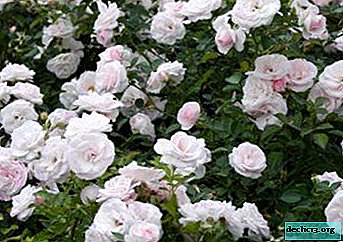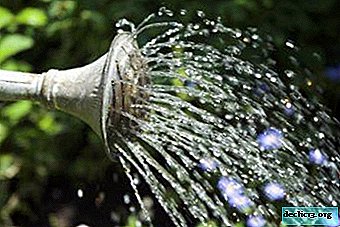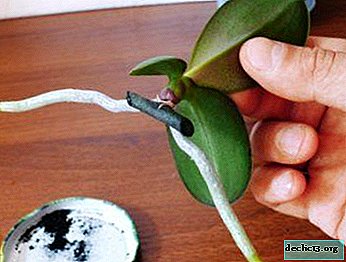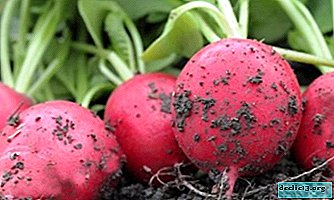Features roses of the Aspirin variety. Description and photos, tips on care and reproduction

There is a huge variety of varieties of roses, each of which has certain characteristics and unique characteristics.
Variety Aspirin is no exception. It is resistant to climate change and has an attractive appearance.
In the article, we will talk about how these roses differ from others, how to properly care for and propagate them. And also tell you what to do if the plant does not bloom.
Detailed description
The Aspirin variety is also known as Aspirin Rose. Ground cover refers to the species. Such flowers are compact, do not exceed 80 cm in height. Foliage with a glossy surface. On the stem 5-10 flowers. Each flower is not more than 6 cm. The variety is distinguished by an unobtrusive pleasant aroma, for which gardeners love it.
The advantages of Aspirin Rose include:
- Frost resistance. The plant winters well under light shelter.
- Self-cleaning. Petals have time to crumble before drying.
- High resistance to disease. Diseases and pests are a rare occurrence for this variety.
- Tolerance to the absence of the sun. Such flowers like to be in the sun, but if it is not there, they feel good in the shade. In this case, they acquire a beautiful pink tint.
The variety has one minus: it needs light fertile soil. If it does not have all the necessary minerals and vitamins, you will often need to feed the plant. Otherwise, it will grow more slowly.
Gardeners note that Aspirin Rose is amazingly resistant to drought, frost, rain, and disease. Neither changes in air temperature, nor moisture, nor pests can destroy the plant. Diseases are extremely rare, only in the absence of care.
Photo
Below you will see a photo of this rose:





History of occurrence
This variety appeared in the German nursery Tantau. Unusual the name of the flowers was in honor of the centennial existence of the drug Aspirin. It belongs to the floribunda roses, experts advise it to plant in the Moscow region and the middle lane, since it is in these places for this plant that the most favorable conditions are.
What is the difference from the rest of the species?
- It differs from other types in shade: the flowers are white, but if the sun does not turn pink enough.
- Small in size: 4-6 cm. The bush is compact, so it fits even on a small garden site.
- Up to 15 flowers ripen on one peduncle, each of which has 50, and in rare cases 60 petals. This creates a beautiful view of the rose, gives it uniqueness and attractiveness.
Bloom
Flowering has certain characteristics that gardeners should familiarize themselves with in advance.
When and how does it happen?
Flowering occurs from June to Septemberbut in warm weather and the sun can continue until November. During flowering, white and light pink buds open, spread their petals.
The average size of the bush and the flowers themselves increase by several centimeters, a pleasant aroma appears.
Care before and after flowering
 Before flowering it is important to pay attention not only to the bushes, but also to the soil: it is fed, weeds removed, and watered. Some inexperienced gardeners mistakenly believe that only leaves need water, but in fact, moisture should also enter the soil.
Before flowering it is important to pay attention not only to the bushes, but also to the soil: it is fed, weeds removed, and watered. Some inexperienced gardeners mistakenly believe that only leaves need water, but in fact, moisture should also enter the soil.- After flowering too long mustaches, branches are removed, continue to care for the soil, supplying it with minerals. Before the onset of cold weather, the plant is covered with ash, branches of spruce, film. Despite the fact that it tolerates frosts well, supercooling is not necessary: this can lead to a decrease in fertility in the next season.
What if there are no buds?
The lack of flowering may indicate that the plant lacks moisture or vitamins. For this, the gardener needs to carefully monitor the condition of the soil. It is recommended to fertilize the soil with calcium nitrate, ammonium nitrate, magnesium sulfate.
Acceptable purchase of fertilizers in flower shops is acceptable. This will help the soil and roots to fill with useful substances, and the plant to bloom.Use in landscape design
Due to its attractive appearance, this variety has gained popularity among fans of landscape design. Aspirin rose is actively planted in the garden, turned into a highlight of the garden.
White, soft pink flowers of a small size are suitable if you want to create coziness, an atmosphere of fabulousness. They are ideal for creating multi-level gardens. Small bushes will decorate even the smallest plot, emphasize the good taste of the gardener, his accuracy and refinement of nature.
Step-by-step care instructions
Care includes several important aspects that gardeners should keep in mind.
Choosing a landing place
The ideal place for this variety should be on the sunny side., and the soil should be fertile. Such flowers love shade, but they also need the sun. A strong wind can ruin the appearance of small flowers, so it is better to choose a place that protects from strong winds.
The width of the bush is 80 cm, so the site should be at least this indicator. Between the bushes leave a place of 20-30 cm.
Time for placement in the ground
Plant a plant in April and May. This is an ideal time for him, as it becomes warm, the sun appears, the soil warms up.
What should be the soil?
Aspirin rose loves fertile, warm soil. Black earth should be preferred, but such a rose grows well on loam.
Landing
 It is carried out using seeds or seedlings.
It is carried out using seeds or seedlings.
- Seeds are placed in a small hole, covered a little with earth and regularly watered. They should not be buried too deep, as this can worsen the condition of the plant.
- Seedlings choose strong, small in size with long, thick roots. They are lightly sprinkled with earth, watered. Small-sized seedlings with thin roots will not bring many flowers.
Temperature
The plant tolerates both low and high temperatures., but the optimal temperature remains an indicator of 24 degrees. Above 27 degrees and below 15 degrees, the indicators become uncomfortable for the plant and reduce its immunity.
Watering
It is a mistake to believe that this plant is watered superficially: only leaves and stems, forgetting about the soil and root system. Proper watering involves a different method.
- It is recommended along the group planting to make a groove with a depth of 10-15 cm, into which water is poured.
- When the water is absorbed, the hole is sprinkled with a small amount of soil.
Top dressing
They begin to feed the plant in late April or early May.. Ammonium nitrate and potassium salt are used. Each component is used in an amount of 10 g per 1 bush. The medicinal components are diluted in 5 l of water. Fertilize by loosening. It is enough to fertilize the soil once a week during this period.
 Two weeks after the first feeding, mullein infusion is used, which is prepared by mixing the main ingredient with water in a ratio of 1:20 per 1 bush. The resulting product watered the soil around the bush.
Two weeks after the first feeding, mullein infusion is used, which is prepared by mixing the main ingredient with water in a ratio of 1:20 per 1 bush. The resulting product watered the soil around the bush.
When buds are formed, calcium nitrate is used, which in the amount of 1 tablespoon is diluted in 10 liters of water. This liquid is watered under the root of the bush.
During flowering, the rose is fed with magnesium sulfate. It is diluted in an amount of 10 g in 10 l of water. The bush is watered under the root, and a little liquid is applied to the leaves.
Weeding
It is carried out regularly. The gardener should inspect the condition of the soil and, if necessary, remove weeds, loosen the soil.
If in the spring there are almost no weeds, then in the summer they appear in large numbers. Weeding is done several times a week..
Mulching
Suitable for this purpose:
- peat;
- wood shavings;
- coniferous litter;
- hay.
Introduce these components in late spring. They persist throughout the summer. Around each bush is mulch, the layer height of which is from 4 to 6 cm.
Loosening
Loosening is necessary for the soil, it is carried out at least once a week so that the soil is in good condition. Spend it very carefully, without injuring the root system.
Pruning
 Dry branches, shoots are removed in the spring and summer. It is also recommended to cut the stems by 10 cm. This will preserve the plant's health. The choice of pruning method depends on the condition of the bush:
Dry branches, shoots are removed in the spring and summer. It is also recommended to cut the stems by 10 cm. This will preserve the plant's health. The choice of pruning method depends on the condition of the bush:
- Preventative. Leave up to 3 buds on each branch, used for weakened plants and to prevent the development of diseases.
- Formative. Leave up to 6 kidneys. It is necessary to achieve early flowering, the formation of a beautiful form of the bush.
Moving to another place
When transplanting, the lower leaves, which may get into the soil, are removed, the upper ones are shortened.
It is necessary to pre-prepare the site: the land should be light, fertile. The stems are planted at a slight angle.
The main thing after a transplant is regular watering, airing in hot weather and shading in intense sunlight.Preparation for winter
It implies several stages:
- sprinkling of the root zone with earth;
- covering branches with dry leaves;
- the construction of frames that are covered with lutrasil.
The main thing, everything necessary for shelter must be dry. Shelter when frosty weather (up to 7-10 degrees) is observed for at least a week, in the middle lane most often this is the end of October.
Step-by-step instructions on how to propagate
Propagate this type of rose using shoots.
- In June, when the formation of buds begins, the annual shoot is obliquely cut half a centimeter under the kidney.
- The upper part of the branch is cut a centimeter from the eye, hoping that the length of the stalk will be 8-10 cm.
Before planting, it is strongly recommended to place the cuttings in the Kornevin solution, which leads to root growth, strengthens them, makes them healthier. Cuttings are allowed to plant in open ground.
Diseases and Pests
 This species is resistant to the appearance of diseases, pests rarely affect the Aspirin rose. Highly powdery mildew and black spotting are rare, but with proper care they can be avoided.
This species is resistant to the appearance of diseases, pests rarely affect the Aspirin rose. Highly powdery mildew and black spotting are rare, but with proper care they can be avoided.
If the plant still gets sick, it is treated with the following means: Inta-Vir or Actellik. They destroy pathogenic bacteria, pathogens of dangerous diseases, maintain a healthy culture.
Rosa Aspirin is a beautiful plant resistant to climate change and disease. Small sized flowers of soft pink and white are real garden decorations. Knowing the features of care, the gardener will grow healthy roses in large numbers.

 Before flowering it is important to pay attention not only to the bushes, but also to the soil: it is fed, weeds removed, and watered. Some inexperienced gardeners mistakenly believe that only leaves need water, but in fact, moisture should also enter the soil.
Before flowering it is important to pay attention not only to the bushes, but also to the soil: it is fed, weeds removed, and watered. Some inexperienced gardeners mistakenly believe that only leaves need water, but in fact, moisture should also enter the soil.















